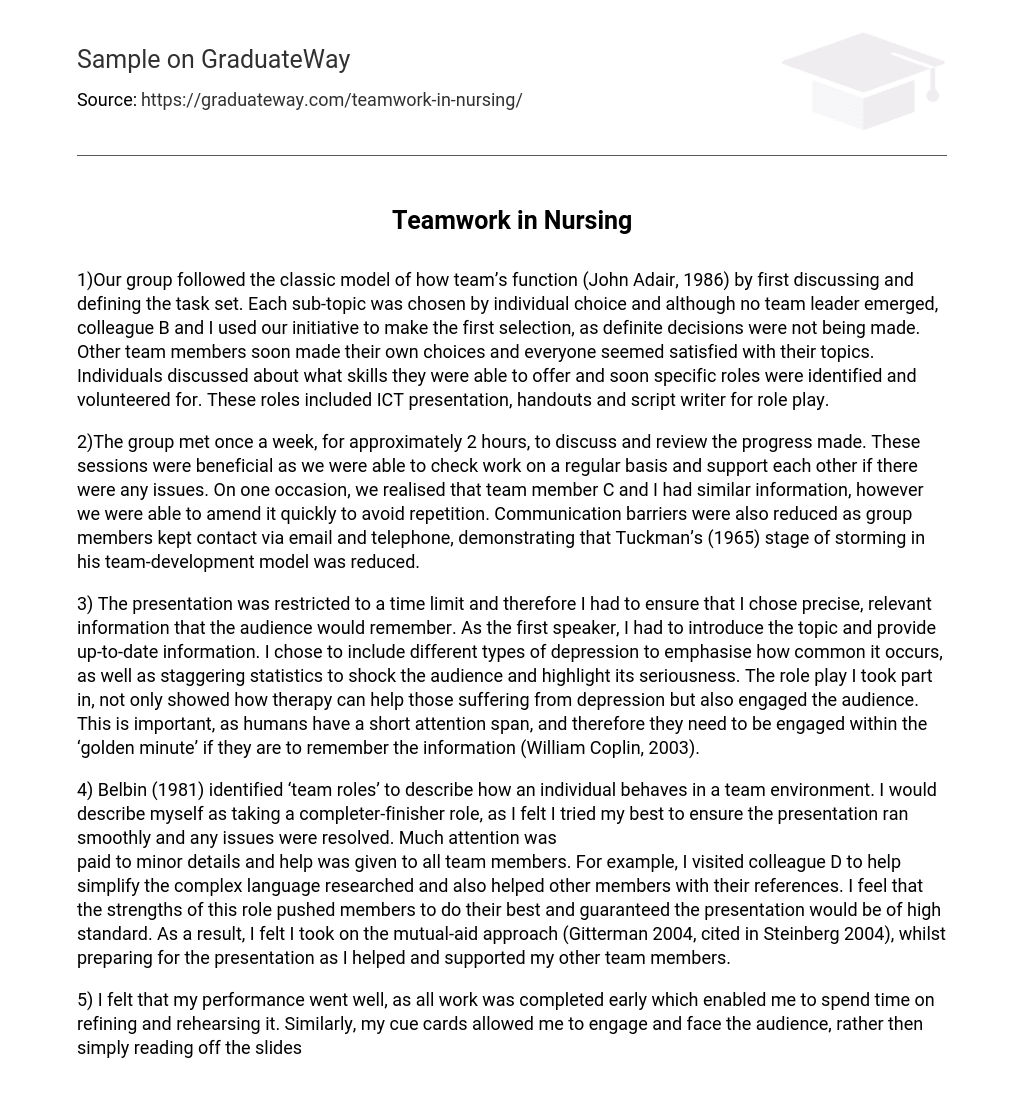1)Our group followed the classic model of how team’s function (John Adair, 1986) by first discussing and defining the task set. Each sub-topic was chosen by individual choice and although no team leader emerged, colleague B and I used our initiative to make the first selection, as definite decisions were not being made. Other team members soon made their own choices and everyone seemed satisfied with their topics. Individuals discussed about what skills they were able to offer and soon specific roles were identified and volunteered for. These roles included ICT presentation, handouts and script writer for role play.
2)The group met once a week, for approximately 2 hours, to discuss and review the progress made. These sessions were beneficial as we were able to check work on a regular basis and support each other if there were any issues. On one occasion, we realised that team member C and I had similar information, however we were able to amend it quickly to avoid repetition. Communication barriers were also reduced as group members kept contact via email and telephone, demonstrating that Tuckman’s (1965) stage of storming in his team-development model was reduced.
3) The presentation was restricted to a time limit and therefore I had to ensure that I chose precise, relevant information that the audience would remember. As the first speaker, I had to introduce the topic and provide up-to-date information. I chose to include different types of depression to emphasise how common it occurs, as well as staggering statistics to shock the audience and highlight its seriousness. The role play I took part in, not only showed how therapy can help those suffering from depression but also engaged the audience. This is important, as humans have a short attention span, and therefore they need to be engaged within the ‘golden minute’ if they are to remember the information (William Coplin, 2003).
4) Belbin (1981) identified ‘team roles’ to describe how an individual behaves in a team environment. I would describe myself as taking a completer-finisher role, as I felt I tried my best to ensure the presentation ran smoothly and any issues were resolved. Much attention was
paid to minor details and help was given to all team members. For example, I visited colleague D to help simplify the complex language researched and also helped other members with their references. I feel that the strengths of this role pushed members to do their best and guaranteed the presentation would be of high standard. As a result, I felt I took on the mutual-aid approach (Gitterman 2004, cited in Steinberg 2004), whilst preparing for the presentation as I helped and supported my other team members.
5) I felt that my performance went well, as all work was completed early which enabled me to spend time on refining and rehearsing it. Similarly, my cue cards allowed me to engage and face the audience, rather then simply reading off the slides. By working in a team, I have learnt that to be successful, individual skills and strengths should be used to an advantage and the work load shared equally. Furthermore, I also learnt from the other members of the group, by discovering different views and opinions. However, if I was to repeat this presentation again I would like to practice my public speaking skills further so that I feel more confident and hopefully won’t speak as fast.
Word Count: 550 words
Reference List
Gitterman, A. (2004), cited in Steinberg, D. (2004) Mutual-Aid Approach to working in groups: Helping people to help one another. 2nd ed. New York: Haworth Press.
Coplin, W. (2003) 10 things employers want you to learn in college. California: 10 Speed Press.
Belbin, M. (2007-2009) Home to Belbin Team Roles [online] Belbin Associates, available from: http://www.belbin.com/ [Accessed on 9 November 2009].
Tuckman, B (1965), cited in Chapman, A (2001) Bruce Tuckman 1965 original Forming-Storming-Norming-Performing Concept [online]. Available from
http://www.businessballs.com/tuckmanformingstormingnormingperforming.html
Adair, J. (1986), cited in Chapman, A (2000) Action Centered Leadership: John Adair’s action centered leadership – a model for team leadership and management [online]. Available from http://www.businessballs.com/action.html [Accessed on 16 November 2009].





